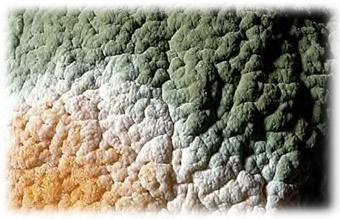![]()

![]()

 |
Division Zygomycota
These fungi are mostly terrestrial and live in soil or on decaying plant and animal material. Once group of major importance forms mycorrhizae, mutualistic associations with the roots of plants. Zygomycete hyphae are coenocytic, with septa found only where reproduction cells are formed. A common zygomycete is black bread mold, Rhizopus stolonifer, still an occasional household pest despite the addition of preservatives to most processed foods. Air currents are not a very precise way to disperse sporeds, but Rhizopus releases the tiny cells in great numbers. Though they drift aimlessly, enough land in hospitable places. Some zygomycetes, however, can actually aim their spores. One is Pilobolus, a fungus that decomposes animal dung. Pilobolus bends its sporangium hyphae toward light, a direction where grass is likely to be growing. The whole sporangium is then shot off on an explosive squirt of cytoplasm out the end of the hypha, sometimes carrying the sporangium as far as 2m. |
| Division Ascomycota
They range in size and complexity from unicellular yeasts to minute leaf-spot fungi to elaborate cup fungi and truffles. However, many are important saprobes, particularly of plant material. About half the ascomycete species live with algae in the symbiotic associations called lichens. Some ascomycetes, including truffles and morels, form mycorrhizae with plants. the defining feature of the Ascomycota is the production of sexual spores in saclike asci. Unlike the zygote fungi, most sac fungi bear their sexual stages in macroscopic fruiting bodies, or ascocarps. Before developing ascocarps, ascomycetes reproduce by producing enormous numbers of sexual spores, which are often dispersed by wind. These spores are not formed inside sporangia, as in the Zygomycota. Such naked spores are called conidia, from the Greek for "dust". Compared to zygomycetes, ascomycetes are characterized by a more extensive dikaryotic stage, which is associated with the formation of ascocarps. Genetic differences between mycelia grown from ascospores taken from one ascus reflect crossing over and independent assortment of chromosomes during meiosis. |
 |
 |
Division Basidiomycota
The name derives from the basidium, a transient diploid stage in the
organism's life cycle. The clublike shape of the basidium also gives rise
to the common name club fungus. Basidiomycetes are important decomposers
of wood and other plant material. The division also includes mycorrhiza-forming
mutualists and plant parasites. Of all fungi, the saprobic basidiomycetes
are best at decomposing the complex polymer lignin, an abundant component
of wood. The life cycle of a club fungus usually includes a long-lived
dikaryotic mycellium. Periodically, in response to environmental stimuli,
this mycelium reproduces sexually by producing elaborate fruiting bodies
called basidiocarps. The numerous basidia of a basidiocarp are the sources
of sexual spores. Asexual reproduction in basidiomycetes is much less common
than in ascomycetes, but also occurs as conidia.
|
| Mold
A mold is a rapidly growing, asexually reproducing fungus. The mycelia of these fungi grow as saprobes or parasites on a great variety of substrates. Molds may go through a series of different reproductive stages. Early in life, a mold produces asexual spores. The term mold applies only to these asexually, producing zygosporangia, ascocarps, or basidiocarps. There are also molds that cannot classified as zygomycetes, ascomycetes, or basidiomycetes because they have no know sexual stages. Among the more unusual imperfect fungi are predatory fungi in soil that trap, kill nad comsume small animals, especially roudn worms, or nematodes. |
 |
 |
Yeast
Yeast are unicellular fungi that inhabit liquid or moist habitats, including
plant sap and animal tissues. Yeasts reproduce asexually, by simple cell
division or by the pinching of small bud cells off a parent cell. Some
yeast reproduce sexually, by forming asci or basidia, and are then classified
as Ascomycota or Basidiomycota. Others place in the division of Deuteromycota
because no sexual stages are know. Some fungi grow as either single cells
or as a filamentous mycelium, depending on the availability of nutrients.
|
| Lichens
A lichen is a symbiotic association of millions of photosynthetic microorganisms tangled in a mesh of fungal hyphae. The fungal component is most commonly an ascomycete, but several basidiomycete lichens are known. The photosynthetic partners are usually unicellular or filamentous green algae or cyanobacteria. The merger of fungus and alga is so complete that lichens are actually given genus and species name, as though they were single organisms. Lichens vary considerable in the details of their architecture and physiology, but there are some key similarities. The fungus usually gives the lichen its overall shape and structure, and tissues formed by hyphae account for most of lichen's mass. The fungi of many lichens reproduce sexually by forming ascocarps or, rarely basdiocarps. Lichen algae reproduce independently of the fungus by asexual cell divsion. As might be expected of dual organism, asexual reproduction as symbiotic units also occurs commonly, either by fragmentation of the parental lichen or by the formation of specialized structures called soredia. Lichens are important pioneers on newly cleared rocks and soil surfaces, such as burned forests and volcanic flows. As tough as lichens are, many do not stand up to air pollution. Their passive mode of mineral uptake from rain and moist air makes them particulary sensitive to sulfur dioxide and other aerial poisons. |
 |